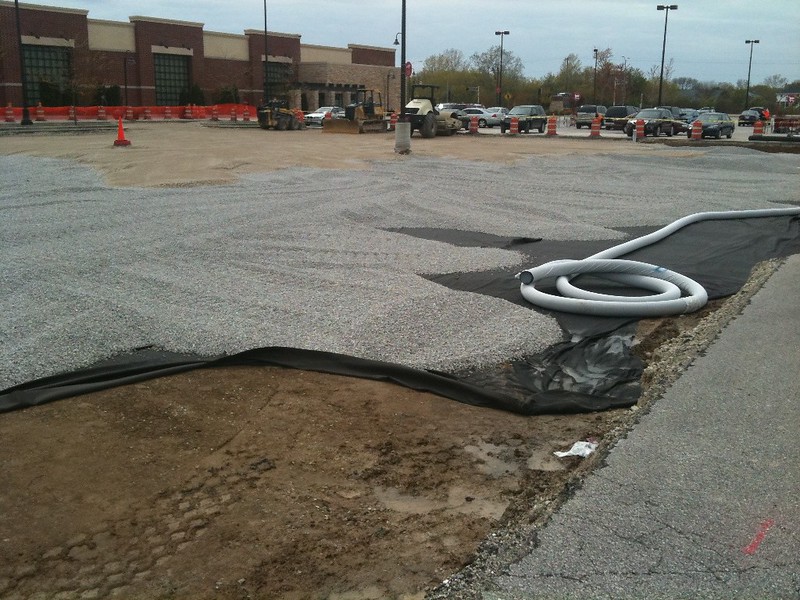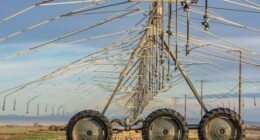Geotextile fabric excels at erosion control, filtration, and soil stabilization, landscape fabric is better suited for weed suppression and moisture retention. When deciding which material to use for your project, consider the specific needs of your site. If you are dealing with a heavily sloped area or need to stabilize loose soils, then geotextile fabric may be the best choice. On the other hand, if you are looking to prevent weeds in planted areas or retain moisture around shrubs or trees, then landscape fabric will likely provide better results.
Landscape Fabric
Landscape fabric is a permeable material that is used to prevent weed growth while allowing water and nutrients to pass through. It’s often made from woven or non-woven polypropylene, which makes it durable and long-lasting. One of the primary benefits of landscape fabric is its ability to suppress weeds, reducing the amount of maintenance required in your garden.
Another advantage of using landscape fabric is that it helps retain moisture in the soil by blocking evaporation. This can be particularly useful during hot summer months when watering plants becomes more challenging.
When installing landscape fabric, it’s important to ensure that there are no gaps or overlaps in the material as this will allow weeds to grow through. Additionally, it’s recommended to use mulch on top of the fabric for added protection and aesthetic appeal.
However, one potential drawback of using landscape fabric is that it can hinder root growth if not installed correctly. Furthermore, while effective at controlling weeds initially, over time small seeds may still germinate on top of the fabric leading to new weed growth.
Landscape fabrics are an excellent option for those looking for low-maintenance gardening solutions with reduced herbicide application needs.
Geotextile Fabric
Geotextile fabric is a type of permeable textile material that has been engineered for use in soil and rock stabilization, drainage systems, erosion control, and road construction. It is made from synthetic fibers that are designed to withstand harsh weather conditions and resist degradation over time.
One of the key benefits of geotextile fabric is its ability to provide filtration and separation functions for soil layers. This helps prevent the migration or mixing of different types of soils which can lead to structural failure or reduced performance. Additionally, geotextiles can be used as a cost-effective alternative to traditional stone aggregate in certain applications such as retaining walls.
There are three main types of geotextile fabrics: woven, non-woven, and knitted. Woven fabrics have high tensile strength but low elongation properties while non-woven fabrics have higher elongation but lower tensile strength. Knitted fabrics offer improved flexibility over woven materials due to their interlocking loops.
Despite its many advantages, there are some disadvantages associated with using geotextile fabric including potential clogging or reduced flow rates in drainage systems if not properly installed or maintained. In some cases where there may be significant water runoff or heavy loads involved, thicker materials may need to be used which can add additional costs.
Choosing the right type of geotexitle fabric depends on a variety factors such as project goals, site-specific conditions and budget constraints. Proper installation techniques should also be followed by experienced professionals for optimal results.
Landscape Fabric Vs. Geotextile Fabric – Key differences
Landscape fabric and geotextile fabric are often used interchangeably, but they have key differences. Landscape fabrics are typically made from woven or non-woven polypropylene materials while geotextiles can be made from various materials like polyester, polyethylene and more.
The primary difference between these two fabrics is their intended purpose. While landscape fabric is designed to suppress weed growth in gardens and flower beds, geotextile fabric serves as a stabilizer for soil erosion control, drainage systems, road construction and other civil engineering projects.
Landscape fabrics usually come in thinner options compared to the thicker varieties of geotextile fabrics that can hold up against heavier loads. Geotextiles are also available in permeable or impermeable forms depending on the project requirements.
Another significant difference between these two types of fabrics is their lifespan. Typically speaking, landscape fabric lasts around 3-5 years before needing replacement whereas geotextiles have a longer lifespan ranging anywhere from 10-20 years depending on the material quality.
In summary, choosing between landscape fabric and geotextile largely depends on your specific needs. For gardening purposes such as suppressing weeds or retaining moisture levels within garden beds then consider using landscape fabric. But if you require long-term stability for your projects such as soil stabilization or drainage solutions then look into utilizing high-quality geotexitle material suitable for your project needs!
How to Choose the Right Fabric for Your Project
When embarking on a landscaping or construction project, choosing the right fabric is crucial to its success. Here are some key factors to consider when selecting between landscape and geotextile fabrics.
Firstly, it’s important to assess the type of project you’re working on. Landscape fabrics work best for projects that require weed control and soil separation. Geotextile fabrics are better suited for drainage applications and erosion control.
Secondly, consider the durability required for your project. If you need a fabric that can withstand heavy loads from vehicles or foot traffic, then geotextile fabric may be more suitable due to its superior strength.
Thirdly, think about the environment in which your project will be located. For instance, if you’re building near water sources such as rivers or lakes, geotextiles would make a better choice since they allow water to pass through while keeping soil particles in place.
Budget is always an important consideration when making any purchase decision. While landscape fabrics tend to be cheaper than their geotextile counterparts per square foot of material used; however it might not provide all necessary benefits needed by specific projects.
Ultimately choosing between landscape and geotextile fabrics comes down to evaluating what requirements need fulfilled by each product versus cost benefit analysis
What are the three types of geotextile fabric?
Geotextile fabric is an engineered material that’s designed to improve soil stability, drainage, and erosion control. There are three types of geotextile fabrics: woven, non-woven, and composite.
Woven geotextiles are made by interlacing two or more sets of yarns at right angles using a weaving process. These fabrics have high tensile strength and can withstand heavy loads without tearing apart. They’re commonly used for road construction projects as they provide excellent separation between the subgrade soil and the base course.
Non-woven geotextiles are made from synthetic fibers bonded together using heat or chemicals. These fabrics have good filtration properties which make them ideal for use in drainage systems where water needs to be filtered before it reaches the surrounding soil.
Composite geotextiles combine both woven and non-woven materials to create a fabric with unique properties that meet specific project requirements. For example, some composites may have a layer of non-woven fabric on one side for filtration purposes while having a layer of woven fabric on the other side for added strength.
Ultimately, choosing the right type of geotextile depends on your specific project needs. Understanding each type’s strengths and weaknesses will help you make an informed decision about which one is suitable for your application.
Advantages and disadvantages of Geotextile Fabric
Geotextile fabric is a versatile material that has become increasingly popular in the construction and landscaping industry. It offers several benefits over traditional landscape fabric, such as superior durability and permeability. However, it also comes with some drawbacks.
One of the biggest advantages of geotextile fabric is its strength. Geotextiles are made from synthetic fibers that are designed to resist tearing, puncturing, and other forms of damage. This means they can withstand heavy foot traffic, vehicle traffic, and even erosion caused by water flow.
Another advantage is their permeability. Unlike traditional landscape fabric which can clog over time due to soil particles accumulating on top of it, geotextile fabrics allow water to drain through them while still preventing weed growth underneath them.
However, there are some downsides to using geotextile fabrics too. One potential drawback is that they do not decompose naturally like organic materials do; this makes disposal more complicated than regular landscape fabrics. Additionally, because they don’t break down easily they could cause issues if installed improperly since roots won’t be able penetrate into the soil below them
Finally yet importantly,a common disadvantage linked to geotexitle fabircs is their cost: They tend to be more expensive than standard plastic or cloth-based alternatives.
Though ,if you want a durable solution for your project – or need extra stability – then Geotexitle Fabric might just be what you’re looking for!
Advantages and disadvantages of Landscape Fabric
Landscape fabric is a material that has been designed to control weed growth in your garden or landscape. It comes with several advantages, including being easy to install and use. The following are some of the benefits of using landscape fabric.
One advantage of using landscape fabrics is that it helps prevent weeds from growing, meaning less time spent on weeding and more time enjoying your garden. Additionally, the fabric can help reduce soil erosion by keeping soil in place during heavy rains or watering.
Another benefit of landscape fabric is that it can help retain moisture in the soil, which is essential for plant growth. By doing so, you will not have to water plants as frequently as before saving you both money and time.
However, like any product out there, landscape fabrics come with their downsides too. One disadvantage of using this type of weed barrier cloth is that they can be difficult to remove once installed because they’re made from synthetic materials such as polyester or polypropylene.
Another drawback may be its inability to break down over time completely; hence microplastics could end up contaminating your soil if left unremoved after years’ worth of usage.
Featured Image By – Aaron Volkening on Flickr








